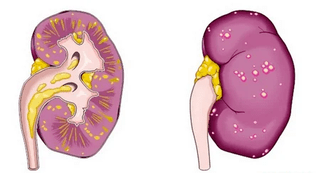
Many doctors jokingly call prostatitis male menopause. The disease is diagnosed in 20% of cases in men after forty years, in 70% - after sixty years and in 90% of cases after seventy years of age. The disease can occur in 2 forms, acute and chronic prostatitis. This disease must be treated, especially since it is conducive to treatment. But many men ignore the unpleasant symptoms that lead to the disease developing into more difficult to treat complications.
Development reason
Acute prostatitis is an acute pathology of the prostate gland that develops due to an inflammatory and infectious process in an organ due to the penetration of a pathogen into its tissues. The disease is characterized by the appearance of swelling of the gland, pus-filled in its tissues.This leads to the appearance of many unpleasant symptoms, a violation of the function of the organs of the genitourinary system.
There are many causes of acute prostatitis. In most cases, it is provoked by pathogenic bacteria.Some bacteria can exist in healthy people passively on the skin or in the intestines. Under the action of a number of factors, they are activated, penetrate the tissues of the gland and actively multiply there. Usually the disease occurs due to STDs, egchlamydia, ureaplasmosis, gonorrhea, v. v.
Additionally, an acute form of prostatitis occurs as a complication ofurethritis. Germs enter through the tubes that open into the urethra. In addition, the spread of bacteria from other organs of the genitourinary system often becomes the cause of the appearance of prostatitis. Often times, the gland is affectedduring surgery, catheterization, diagnostic measures.
Because there are a large number of blood vessels in the prostate gland, infection can enter here through the bloodstream when there is a chronic disease in the body, for example,tonsillitis, bronchitis, v. v.Whenan anal fissureis present, bacteria can enter the prostate gland along with the lymphatic flow.
But not always an infection leads to the development of the disease. Blockage in the vessels of the pelvic region, developingwhen abstaining from prolonged sex or a large number of them.
Obstruction is also associated withlack of physical activity, constant constipation, alcoholism, pelvic varicose veins, hypothermia.
Category
In urology, several forms of pathology are distinguished, also the stages of their development:
- The catarrhal formis characterized by the appearance of inflammation in the organ, a change in its mucous epithelium. Over time, a swelling of the gland occurs, a mucus secretion is collected in it, which contributes to the progression of the disease.
- The focus is then on. The disease enters a second stage (form) -cystic form. The urinary duct is narrowed or blocked, and the secretions are no longer normally excreted from the organ. It is possible to secrete pus into the urinary tract, forming pus there. The cells of the gland change, and the prostate continues to swell and increase in size.
- Parenchyma formdevelops when the organ is completely inflamed, a purulent infection develops in it. In the absence of treatment, small purulent foci fuse into a large mass, an abscess develops, often opening into the urethra, intestines and bladder. In some cases, this form of pathology can immediately develop when the infection enters the interstitial tissue of an organ with the outflow of blood or lymph.

Symptoms
Shows symptoms of acute prostatitis. The intensity of the signs to be seen and felt will depend on the type (stage) of the disease. Common signs of the disease include:
- pain syndrome
- during urinary excretion;
- intoxication symptoms;
- pain in the genital area;
- had frequent urge to go to the bathroom, especially at night;
- can discharge fluid from the urethra.
As a man's prostatitis progresses, the pain syndrome spreads to other areas. This is due to the impulse propagation along nerve endings. The excretion of urine becomes very painful. Usually at this stage, acute delay develops, which is considered a dangerous condition, as it can lead to bladder rupture.
Symptoms of acute prostatitis continue to increase. Severe pain during bowel movements, increased body temperature. The prostate gland becomes enlarged, tight, and painful. The urine will be cloudy due to the mixture of pus and mucus.
In the late stage, the disease manifests itself strongly.
The body temperature increased greatly, accompanied by fever and chills, anorexia, severe weakness, and general exhaustion. The urination may stop completely and the man will experience severe pain when trying to use the toilet. The condition became worse and worse, pain syndrome began to spread throughout the pelvic area. A man cannot find a place for himself, he is forced to lie with his hands and feet tight. If the infection has spread to the rectum, mucus will drain out of the anus. Bloody green-yellow mucus is secreted from the urinary tract.

This condition can causesepsis, cystitis, pyelonephritis, chronic prostatitis, an abscess. In this case, the patient needs urgent and emergency hospitalization.
Diagnosis
Because the symptoms of acute prostatitis in men are quite obvious, the doctor can immediately suspect the pathology. But he needs to be thoroughly examined. Rectal examination in this case is a strict contraindication.
Urologists must determine the stage (form) of the disease using laboratory and instrumental techniques. The doctor took asecret prostate glandfor examination. WBC concentration will increase which indicates acute inflammation.
Thenlab blood and urine tests were performed. Urine is sent for bacterial culture for testing, as well as for identifying the infectious agent and its susceptibility to antibacterial drugs. Can also do:
- PCR for STD detection;
- measures uroflow to determine the severity of an internal disorder;
- Ultrasound of the prostate gland to determine the shape and size of the organ, changes in it, the stage of the disease; Measurement of
- helps to distinguish acute prostatitis from other conditions;
- MRI of pelvic organs is often indicated when planning surgical intervention;
- analyzes the concentration of SPA in the blood;
- check for stains of urethral discharge; Puncture
- parts of the organ in case of suspected infection and purulent abscess.
Treatment
Urologist will tell you in detail how to treat acute prostatitis. The main component of therapy is an antibacterial drug, selected in accordance with the results of bacterial culture. Within two or three days, the antibiotic began to work, and the person felt much better, the pain began to subside. But with this form of the disease, such drugs need to be taken for a month, even if the symptoms have completely disappeared.
It is also important to avoid the disease becoming chronic, which is quite common.
When choosing a drug, the doctor must take into account other factors:
- some agents do not penetrate well into the tissues of the gland;
- other agents accumulate in tissue in large numbers.
Treatment of acute prostatitis in men should be based on the use of strong drugs, as in other cases life-threatening of the patient. Usually the doctor prescribes fluoroquinolones. When using macrolide, the dosage must be large. This is especially true in immunosuppressed patients.
Antibiotics are usually given by injection into a vein. In its early stages, it can be treated at home or out of the hospital.In this case, bed rest is prescribed, as any electrical load can cause spread and develop sepsis.
In combination with antibiotics, the following drugs are also prescribed:
- pain reliever;
- antipyretics;
- NSAIDs;
- opium can be prescribed for severe pain;
- diuretics to reduce the body's toxicity;
- laxative to aid bowel movements;
- antispasmodic drug to facilitate urinary excretion;
- alpha blockers.
If a man has acute urinary retention, a urea catheter is placed. Antigens are often used to reduce swelling and inflammation in organs, improve the flow of secretions, normalize blood flow in the glands, and reduce the risk of infection spreading throughout the body.
Uses hormones like estrogen, an enema to reduce swelling and pain. Massage and thermal procedures for this form of the disease are strictly prohibited. They can only be applied during recovery.
Surgery

In the absence of pain, the doctor may suspect the development of an abscess. In this case, surgical intervention is performed to remove the area where it happened. Commonly used abscess drainage. In severe and severe cases, the internal organs are removed.
Surgery is indicated in the presence of abscesses, acute urinary retention, severe pain syndrome that cannot be eliminated with any drugs, appearance of stones and tumors, as well as drug therapyineffective, frequent genital system infection, inflammation of the lower gland.
Surgeons may use one of the following techniques:
- TRUP (inhalation resection)involves internal organ rejection. Most commonly used;
- Prostateectomyinvolves partial or complete removal of an organ through an incision in the lower abdomen;
- Laser surgery. In this case, the affected area of the organ is removed using a laser;
- Drainage abscessthrough the rectum. A drainage tube is inserted into the incision, through which pus is pumped out;
- To facilitate urinary excretion, agastrointestinal incisionwas made in the organ.
When the structure of the tissues of the gland is restored, its functions are normalized, the prostate gland normalizes its composition, the pathogen is completely eliminated. body, we can talk about the cure for prostatitis.
Forecast
With therapy, the prognosis is good. Sometimes negative consequences of acute prostatitis develop. The disease can become chronic, then it becomes harder to eliminate. The dangerous consequences of untreated disease are internal abscesses, sepsis, and acute urinary retention. In some cases, due to the appearance of complications, it is possible to die. But usually men don't allow such consequences to develop, since they go to see a doctor and start a course of treatment.
Precautions

For prophylactic purposes, it is necessary to prevent the emergence of pathogenic factors. This requires timely treatment of all infections in the body so that they do not become chronic and not become a potential reservoir of infection that will spread to the prostate gland.
When performing surgical procedures, the use of an antiseptic should be considered. If not, the risk of bacteria entering the patient's body increases. It is important that a man and his partner get timely treatment for STDs and, best of all, to prevent their occurrence. Sex life should happen with a regular partner, it should be regular.
Need to have an active lifestyle, play sports or exercise, obey the rules of physical hygiene.
Men often see a doctor in case of an emergency. But when the negative signs appear, it's better to contact them right away. This will help avoid many health problems and may even save lives in some cases.


























